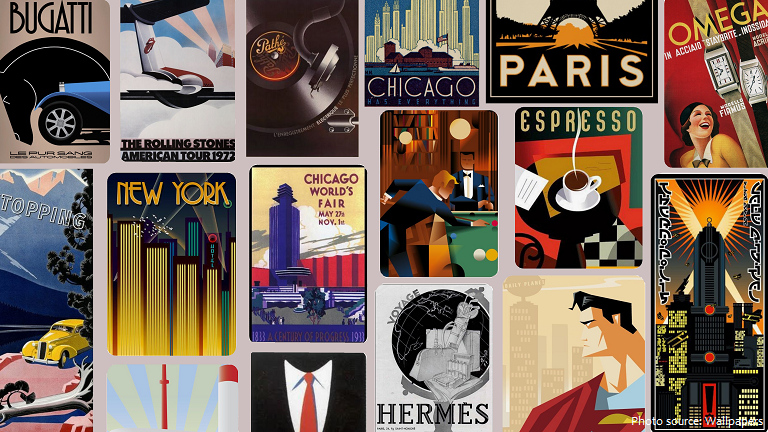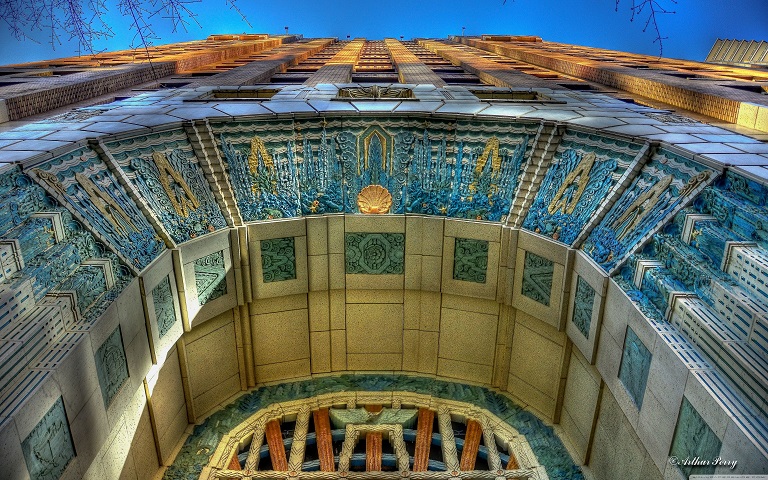
Art Deco, sometimes referred to as Deco is a movement in the decorative arts and architecture that originated in the 1920s and developed into a major style in western Europe and the United States during the 1930s.
It combined modern styles with fine craftsmanship and rich materials. During its heyday, it represented luxury, glamour, exuberance, and faith in social and technological progress.
Art Deco is most commonly associated with a sleek aesthetic, symmetrical geometric shapes and bold bright colors like yellow, purple, ruby and turquoise.
Skyscrapers, furniture, and everyday objects were embellished with angular patterns like zigzags, sunburst and chevrons.

Automobiles, trains, ocean liners and other means of transport began to take on a more futuristic, aerodynamic look. Steel, glass and lacquered wood were used to achieve that sleek, modern look.
Art Deco owed something to several of the major art styles of the early 20th century. These formative influences include the geometric forms of Cubism, the machine-style forms of Constructivism and Futurism, and the unifying approach of Art Nouveau. Its highly intense colours may have stemmed from Parisian Fauvism. Art Deco borrowed also from Aztec and Egyptian art, as well as from Classical Antiquity. Unlike its earlier counterpart Art Nouveau, however, Art Deco had no philosophical basis – it was purely decorative.
Arts décoratifs was first used in France in 1858 in the Bulletin de la Société française de photographie. In 1868, the Le Figaro newspaper used the term objets d’art décoratifs for objects for stage scenery created for the Théâtre de l’Opéra. In 1875, furniture designers, textile, jewellers, glass-workers, and other craftsmen were officially given the status of artists by the French government. In response, the École royale gratuite de dessin (Royal Free School of Design), founded in 1766 under King Louis XVI to train artists and artisans in crafts relating to the fine arts, was renamed the École nationale des arts décoratifs (National School of Decorative Arts).

The Théâtre des Champs-Élysées (1910–1913), by Auguste Perret, was the first landmark Art Deco building completed in Paris. Previously, reinforced concrete had been used only for industrial and apartment buildings, Perret had built the first modern reinforced-concrete apartment building in Paris on rue Benjamin Franklin in 1903–04.
At the 1925 Exposition, architect Le Corbusier wrote a series of articles about the exhibition for his magazine L’Esprit Nouveau, under the title “1925 EXPO. ARTS. DÉCO.”, which were combined into a book, L’art décoratif d’aujourd’hui (Decorative Art Today). The book was a spirited attack on the excesses of the colourful, lavish objects at the Exposition, and on the idea that practical objects such as furniture should not have any decoration at all; his conclusion was that “Modern decoration has no decoration”.
The Art Deco style, adopted by architects and designers around the world, spanned the “Roaring Twenties”, the Great Depression of the early 1930s, and the years leading up to the Second World War. It suffered a decline in popularity during the late 30s and early 40s, when it began to be seen as too gaudy and ostentatious for wartime austerity, after which it quickly fell out of fashion.

Although the style went out of fashion in most places during World War II, beginning in the late 1960s there was a renewed interest in Art Deco design. Into the 21st century Art Deco continued to be a source of inspiration in such areas as decorative art, fashion, and jewelry design.
The actual term “art déco” did not appear in print until 1966, in the title of the first modern exhibition on the subject, held by the Museum of Decorative Arts in Paris, Les Années 25 : Art déco, Bauhaus, Stijl, Esprit nouveau, which covered the variety of major styles in the 1920s and 1930s. The term was then used in a 1966 newspaper article by Hillary Gelson in The Times (London, 12 November), describing the different styles at the exhibit.
Some of the most outstanding examples of Art Deco design can be found in New York City. These include the stunning Chrysler Building, designed by architect William Van Alen, with its polished stainless-steel spire that became an emblem of modernity.

The Empire State Building, designed by Shreve, Lamb & Harmon is another emblem of the Art Deco era, built in 1931, with bold, angular shapes and a streamlined simplicity that filled the city of New York with hope and optimism for the post-war future.
Art Deco was the design choice for movie theaters of the era, such as Grauman’s Egyptian Theater in Los Angeles and Radio City Music Hall in New York City.
Art Deco was also the guiding principle for stylish transportation, such as Bugatti Type 57SC Atlantic automobiles, trains like Henry Dreyfuss’ 20th Century Limited and luxury liners like the Queen Mary.